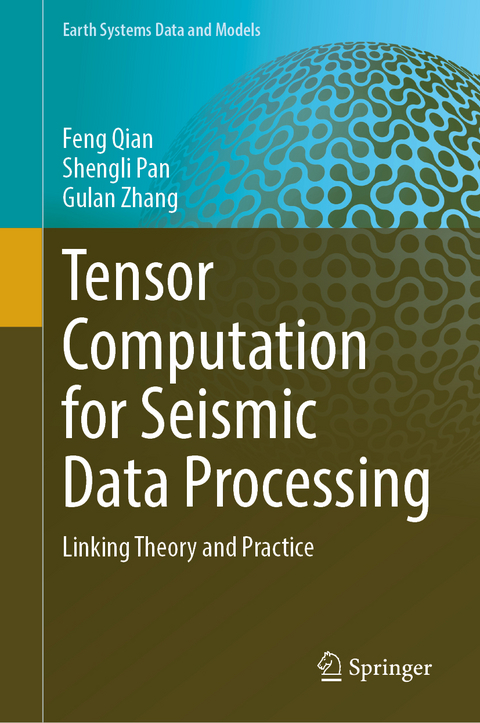
Tensor Computation for Seismic Data Processing
Springer International Publishing (Verlag)
978-3-031-78899-4 (ISBN)
- Noch nicht erschienen - erscheint am 13.05.2025
- Versandkostenfrei innerhalb Deutschlands
- Auch auf Rechnung
- Verfügbarkeit in der Filiale vor Ort prüfen
- Artikel merken
This book aims to provide a comprehensive understanding of tensor computation and its applications in seismic data analysis, exclusively catering to seasoned researchers, graduate students, and industrial engineers alike. Tensor emerges as a natural representation of multi-dimensional modern seismic data, and tensor computation can help prevent possible harm to the multi-dimensional geological structure of the subsurface that occurred in classical seismic data analysis.
It delivers a wealth of theoretical, computational, technical, and experimental details, presenting an engineer's perspective on tensor computation and an extensive investigation of tensor-based seismic data analysis techniques. Embark on a transformative exploration of seismic data processing-unlock the potential of tensor computation and reshape your approach to high-dimensional geological structures.
The discussion begins with foundational chapters, providing a solid background in both seismic data processing and tensor computation. The heart of the book lies in its seven chapters on tensor-based seismic data analysis methods. From structured low-tubal-rank tensor completion to cutting-edge techniques like tensor deep learning and tensor convolutional neural networks, each method is meticulously detailed. The superiority of tensor-based data analysis methods over traditional matrix-based data analysis approaches is substantiated through synthetic and real field examples, showcasing their prowess in handling high-dimensional modern seismic data. Notable chapters delve into seismic noise suppression, seismic data interpolation, and seismic data super-resolution using advanced tensor models. The final chapter provides a cohesive summary of the conclusion and future research directions, ensuring readers facilitate a thorough understanding of tensor computation applications in seismic data processing. The appendix includes a hatful of information on existing tensor computation software, enhancing the book's practical utility.
Prof. Feng Qian received the B.S. and M.S. degrees from Sichuan University (SCU), Chengdu, China, in 2001 and 2004, respectively, and the Ph.D. degree from the University of Electronic Science and Technology of China (UESTC), in 2008. Since 2009, he has been with the School of Information and Communication Engineering and the Centre for Information Geoscience, UESTC, where he is currently Associate Professor. From August 2014 to August 2015, he was Visiting Scholar at Columbia University, New York, NY, USA.
Prof. Shengli Pan received both his B.E. and Ph.D. degrees from the University of Electronic Science and Technology of China (UESTC), in 2011 and 2016, respectively. He was a visiting Ph.D. student in the Swiss Federal Institute of Technology in Lausanne (EPFL) during 2014 to 2015, supervised by Prof. Katerina Argyraki. From 2017 to 2020, he worked as a post-doc with Prof. Ying-Chang Liang in the National Key Laboratory of Science and Technology on Communications, UESTC. He has been an associate professor both in the School of Cyberspace Security, Beijing University of Posts and Telecommunications (BUPT), and the Key Laboratory of Trustworthy Distributed Computing and Service (BUPT), Ministry of Education since 2021.
Prof. Gulan Zhang (not Gulan Z hang) received the B.S., M.S., and Ph.D. degrees in geophysical prospecting and information technology from the Chengdu University of Technology, Chengdu, China, in 2004, 2008, and 2016, respectively. From June, 2008 to March, 2017, he worked for Bureau of Geophysical Prospecting Inc., (BGP), China National Petroleum Corporation (CNPC), Zhuozhou, China. He has been a currently Professor with the School of Geoscience and Technology, the State Key Laboratory of Oil and Gas Reservoir Geology and Exploitation, Southwest Petroleum University, Chengdu, China, since April, 2017.
Introduction.- The Foundations of Tensor Computation.- Tensor Completion for Seismic Data Reconstruction.- Tensor Low Rank Approximation for Seismic Footprint Suppression.- Tensor Deep Learning for Seismic Data Interpolation.- Transform Based Tensor Deep Learning for Seismic Random Noise Attenuation.- Order Tensor Deep Learning for Seismic Data Denoising.- Robust Tensor Deep Learning for Seismic Erratic Noise Attenuation.- Tensor Dictionary Learning for Seismic Data Super Resolution.- Conclusion and Future Research Directions.
| Erscheint lt. Verlag | 13.5.2025 |
|---|---|
| Reihe/Serie | Earth Systems Data and Models |
| Zusatzinfo | Approx. 300 p. 75 illus., 70 illus. in color. |
| Verlagsort | Cham |
| Sprache | englisch |
| Maße | 155 x 235 mm |
| Themenwelt | Naturwissenschaften ► Geowissenschaften ► Geologie |
| Schlagworte | Artificial Intelligence (AI) • Deep learning • Seismic Data Reconstruction • Seismic Noise Suppression • tensor decomposition |
| ISBN-10 | 3-031-78899-0 / 3031788990 |
| ISBN-13 | 978-3-031-78899-4 / 9783031788994 |
| Zustand | Neuware |
| Haben Sie eine Frage zum Produkt? |
aus dem Bereich


